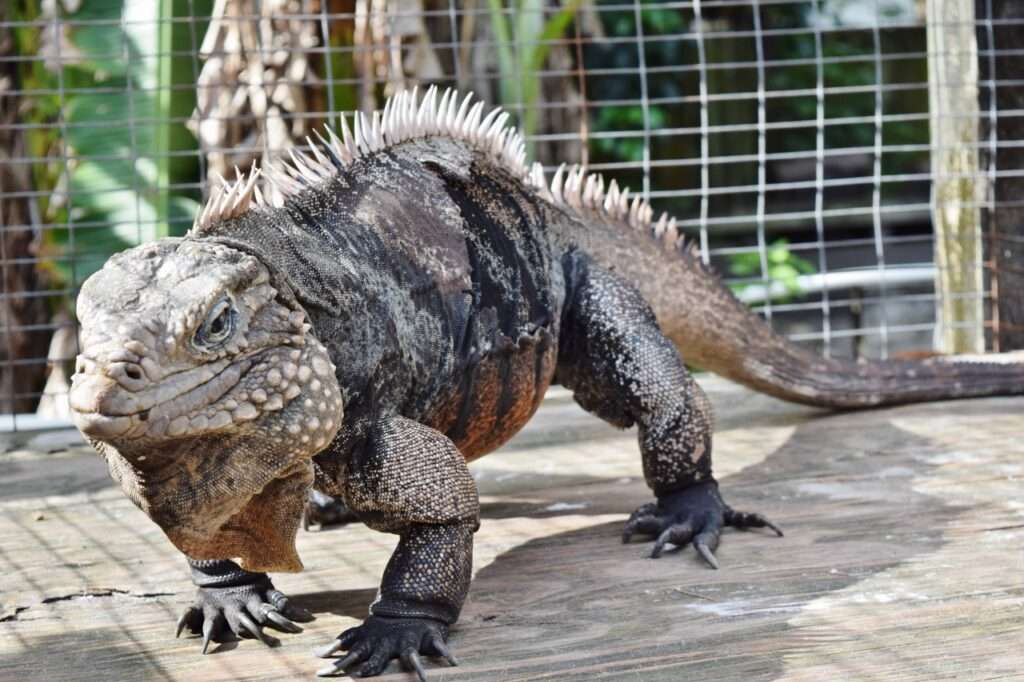
Description:
Scientific name: Cyclura nubila
Life span: 60-70 years
A species of lizard belonging to the iguana family is the Cuban rock iguana (Cyclura nubila), commonly referred to as the Cuban ground iguana or the Cuban iguana. Males of the species are larger than females and have enlarged femoral pores on their thighs, which they utilize to emit pheromones to attract mates and mark territory. The species is sexually dimorphic.
Male Cuban iguanas have dark grey to brick red skin, while females have olive green skin with dark bands or stripes. Both sexes have solid black feet and black limbs with pale brown oval markings.
Juvenile animals typically have five to ten transverse bands of light to dark mottling or striping across their bodies. As the iguana ages, these bands become more like the body colour. Both sexes have a spine-lined row running down their backs to their thick tails, as well as a dewlap (skin hanging below the neck). Their teeth are substantial and wide, and they have strong jaw muscles. They have short, robust heads and necks.
Native Region/Habitat
The Cuban iguana inhabits the island’s rugged coastlines and up to 4,000 islets that encircle it, with Isla de la Juventud off the southern coast having one of the most dense populations. Populations can be found in protected areas on the mainland as well as on islets off the north and south coasts. They are located in eastern Cuba and include the Delta del Cauto Wildlife Refuge, Hatibonico Wildlife Refuge, Punta Negra-Quemados Ecological Reserve, and Guanahacabibes Biosphere Reserve in the west.

Behavior:
Large, heavily-muscled lizards like Cuban Rock Iguanas have a tendency to move slowly and frequently remain stationary for extended periods of time. Even so, they have the ability to move quickly—just not for very long. In order to flee from predators, young Cuban Rock Iguanas are more inclined than adults to climb trees.
These iguanas are rather calm, and some even allow their owners to pet them. Nonetheless, you should use caution when handling them because they have powerful jaws that are capable of delivering a bite that is dangerously strong. Despite the fact that they are often not aggressive creatures, you should always handle them with thick gloves on.
Care As a pet/In captivity:
- The Cuban Rock Iguana is native to Cuba, as suggested by its name, and prefers to live on the island’s rocky and sandy beaches. These iguanas need a big enclosure that is at least 8′ x 4′ x 6′ in size to be kept in captivity. For your iguana to have access to shelf for basking, the enclosure must be tall enough. It is advisable to keep your lizard’s enclosure outside if you reside in a warm region. Be sure your home can handle an enclosure big enough for your lizard if you live in a cool environment.
- The substrate for juvenile Cuban Rock Iguanas can be alfalfa pellets. Any number of materials, including sand, soil, cypress mulch, and even newspaper, will work for adults. Both young and adult Cuban Rock Iguanas need a place to bask that is at least 120 degrees Fahrenheit. For your mature iguana’s heating requirements, you will need to buy numerous heat lamps. In the cooler end of the enclosure, the temperature should be at 75° F and shouldn’t get higher than 80–85° F.
- Despite being a tropical species, Cuban rock iguanas can withstand relatively low humidity, thus a decent range to aim for is between 40 and 80% on average. A digital hygrometer mounted on a wall should be used to measure humidity in the enclosure’s center.
Table





